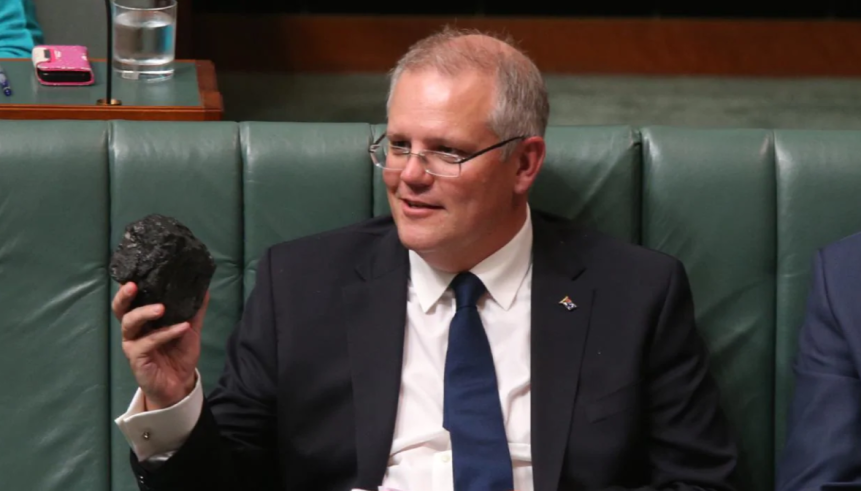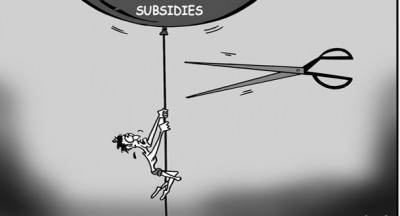
The wind and solar ‘industries’ are in meltdown, as Governments throw $billions at the unemployed, workers and businesses in their responses to their COVID-19 shutdowns.
It seems like only yesterday when renewable energy rent seekers were able to tap into an endless stream of taxpayer subsidies, government backed fixed-price contracts, soft loans, mandates and targets.
In the USA, wind and solar subsidy suckers sought to snaffle $billions out of the Trump administration’s $2 trillion coronavirus aid package. But to no avail.
With no respite from government enforced shutdowns on the horizon, the wind and solar industries must recognise that their days are numbered.
Governments everywhere are throwing their entire fiscal armoury at keeping their economies from dipping into a 1930s like depression. Which, of course, if the shutdowns continue for much longer is where countries like Australia and the USA are headed.
In Australia, the Federal government has signed up taxpayers to the tune of more than $300 billion in promised welfare to the unemployed, business and workers.
With that kind of generosity, there won’t be much left over for the subsidies, schemes and scams of the kind that created and sustains wind and solar power outfits. And, in any event, handing out more taxpayer’s cash to prop up the renewable sector is hardly the most politically astute move that a government signing up its citizens for hundreds of billions of dollars in debt could make.
Alan Moran tackles the topic with a look at a list of the things that simply have to give if governments ever want to balance the books in the future, massive and endless subsidies to wind and solar being only the most obvious.
ScoMo’s gone as crazy as Kev, but we can still save the economy
Spectator Australia
Alan Moran
2 April 2020
When the Prime Minister and Treasurer appointed Stephen Kennedy as the Treasury Secretary, they opted for a bureaucrat who had been the architect of Turnbull’s potentially disastrous carbon tax. They would also have known him to have been a senior adviser on Kevin Rudd’s exorbitant spendathon following the 2008 global financial crisis.
Unsurprisingly, the Secretary of the Treasury recommended that the government implement a “Full Rudd” coronavirus program, suggesting the British approach was insufficiently stimulatory. Ministers need little encouragement to embark on spending sprees but in times past Treasury used to be a brake on their ambitions.
Australia’s spending now totals $320 billion. At 14 per cent of GDP this is a magnitude similar to that of the UK program, though larger than that of the US at least fivefold that of Japan, Canada, Korea, Norway or New Zealand.
Commonwealth spending programs go well beyond maintaining the nation’s businesses and sustaining those who are unemployed and extends into Keynesian economic stimulus territory. The stimulus effect will be ineffective but the resultant debt will be a Sword of Damocles hanging over the economy, squeezing the availability of investment funds for decades. We will likely emerge with a permanently enlarged government share of the economy and its corollary of a lasting reduction in economic growth.
But there is a way of avoiding this. Converting Australia’s fabulous natural wealth into real incomes has been impaired by decades of regulatory impediments thrown up by governments mainly targeting the chimera of a green nirvana. The nine years delay and hundreds of millions of dollars that the successive green objections to the Adani coal mine is one testimony to the effects of the barriers in place.
Clearing away this regulatory detritus is essential if we are to get the economy roaring into an income-enhancing growth phase.
As for paying back the $320 billion debt and easing consumer cost impacts, we have the option of rescinding many policies that continue to slug the economy. Three of these comprise terminating green follies that have generated massive excessive costs in Murray-Darling water, the subsidies for renewable energy and the submarine program.
The Murray Darling Basin Plan has reduced farmers’ irrigation water by some 20 per cent. Irrigation water is a basic agricultural input in an area that produced over 35 per cent of the nation’s farm output. The Murray Darling Basin Authority has $3-4 billion of the $13 billion originally allocated to it for buying up water and for water saving engineering measures. Though not cost-beneficial those water saving measures have led to a de facto increased environmental water supply.
The MDBA holds about 2,200 gigalitres of water worth upwards of $3 billion. This should be sold back to farmers. With the cancellation of MDBA’s remaining funds, this would result in a total saving of some $7 billion. It would also bring a massive dividend in restoring the prosperity of the region, while boosting national food production.
Commonwealth spending on energy subsidies are paid either out of taxes or through forced increases in costs to customers. Direct spending through the budget includes that on the “Clean Energy Finance Corporation”, the Australian Renewable Energy Agency, the Clean Energy Regulator, Global Capture and Storage of carbon and CSIRO’s climate and energy work. This comes to over $1.6 billion a year, all of which is wasted, with much having a negative value. In addition, there are the renewable energy requirements which at current prices cost consumers over $2.7 billion a year.
These measures at $4.3 billion a year could be terminated and save some $43 billion over a decade.
Finally, we have the folly the diesel retrofit of the French Barracuda nuclear submarine – a choice designed to prevent greens from going troppo. The intended $50 billion spend has now blown out to $225 billion. Taking the nuclear option or the German Type 216 might save $100 billion over the next 30 years.
These three programs alone can save $150 billion taking us halfway towards eliminating the expenditure levels now in place.
The present economic shock may be the most serious we have ever seen. Even when governments relax restraints on activity, an economic restructuring will be needed to reflect demand changes. This requires a more flexible economy, part of which entails a reduced public sector cost burden. In addition, Australia right now needs a bonfire of the regulatory distortions that were introduced at a time when we thought we could impose such costs. Will a government that has to date proved unable to wind back excessive regulatory spending or resist arguments from its advisers for excessive spending prove capable of such reforms?
Spectator Australia


Reblogged this on ajmarciniak.
The Governments in Australia have done a great job in trying to get us through this horrible period. They have not shied away from what they had to do to see that people can survive not only the Virus itself but the results of having to shut our Nation and States down to prevent it spreading as it has done elsewhere. We as citizens in most cases have done what we have been asked and are looking to survive without the massive loss of life other Nations have and are facing.
To do this the Government has had to provide financial aid in many ways to keep our economy afloat and as many as possible in employment.
As a result we will have some hard financial times ahead, but one way Governments both Federal and State/Territory can offset the financial cost to the people is to SHUT DOWN THE GRAFTING/THEFT performed by the Renewable’s Industry.
This period has shown that no matter what, this industry will continue to grab our Public Purse and in the process bleed us dry.
If this industry cannot stand on its own feet now it never will and we know they have no intention of even trying to, so what do we owe them – nothing.
In the past weeks wind has been all but dead for many hours at a time, yet so many people are now reliant on energy as they are spending most of their time at home and trying to keep themselves and their children ‘entertained’ and educated.
The evidence is, when energy is needed it cannot be trusted to be there and if it is it is not at a price people can easily afford.
We have been having some very nice warm days, so the full force of the situation has not hit.
What will happen when the wind has died and the nights and even days are very cold and the sun is lurking behind clouds or gone over the horizon at night?
More energy will be needed to heat up homes that prior to the Virus would have been switched off for most of the day with people at work or school.
What will happen if those very cold days are also still of wind and clouded over – what will keep the ‘home fires burning’ – not electricity if there’s not sufficient able to be produced by the few old reliable sources, and we are left ‘hanging’ due to the lack of wind and sunshine.
Hopefully not only Governments will come to their senses and begin to realise we need reliable anytime energy sources to be performing, but the people will also realise Renewable’s are a pipe dream that cannot be fulfilled in any modern society.
Not only that but the money spent on this industry over the years could have ensured our hospitals were fully prepared for such a crisis as we are living through.
Not only that but there could have been full employment in this Nation if companies had not had to go offshore to survive due to the high cost of energy in this country.
The cost of doing business, buying a house, car, clothes, food would have been in the realms of all to achieve, if the cost of energy was what it should be.
We cannot let this experience not teach us anything, we have to come out of this, yes with a National and State debt, but one which we can overcome IF we return to sanity and start working toward bringing our industries back to this country because we have come to our senses and decided Renewable’s and all that they have cost us have seen their day and what is needed is a return to the rational production of the ESSENTIAL SERVICE of energy for all, when and where it’s needed, at a cost which is not prohibitive but encourages it’s use, utilising production methods that are safe, reliable and cost effective.
We need to immediately begin the process of building new clean coal energy plants as well as utilising the vast resources we have to produce nuclear energy.
We have the opportunity to do this, to see our Nation re-build and be a productive, clean environmentally sound exporter of clean healthy medications, medical equipment, clothing, machinery, white goods, products produced from our own wool, leather, food that is produced grown, canned and packaged here in Australia.
We can achieve an economy where Australians have first pick at all we produce and the rest of the world can purchase the remainder.
At the end of this current period we want to see Australia rise up and fulfil its possibilities.
Yes its going to take some work but when has it been beyond us to to work hard for ourselves and our future generations, we are made up of a huge land mass, we have the people to do the work, we have the resources to achieve a life everyone can be proud off and keep Australia clean, green, healthy and productive.
Put the renewable energy industry in its place, knock it from its pedestal and let the country breath and prosper again.
Reblogged this on uwerolandgross.